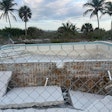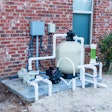
Whenever I talk to another pool professional about calculating heater size, I usually see their eyes glaze over. Not that sizing a pool heater is super difficult, but if you want to do it right, you need to do some calculations first.
Similar to pumps, sizing heaters isn’t usually “calculated.” It’s usually a matter of picking a model you’ve used in similar applications. For example, if you’re working on a pool with an attached hot tub, most installers would suggest a 400,000-Btu heater, which is the largest available in most residential applications.
In that case, a pro might not feel he or she needs to run the calculations because they know the attached hot tub, circulated at pool temperature, will need to be heated before use. And the higher the Btu output of the heater, the faster the heater will raise the water from pool temperature to spa temperature.
Nobody wants to turn on their spa two hours in advance just for it to warm up. With a giant 400,000-Btu heater, an average 8-by-8-foot spa could go from 80 degrees up to 104 degrees in about an hour. (More on that later.)
Similarly, when a homeowner asks what size heater they should use, most installers just pick their favorite heater that is between 200,000 and 350,000 Btu, knowing from experience that it will work on a pool approximately the size of the one in question.
That “guesstimation” works to a certain degree, but this article is intended to help you get comfortable with quick calculations so you know you’re making good decisions. Nobody wins when you install a new heater, only to find it doesn’t keep the pool warm enough or needs to run constantly to maintain the desired temperature.
MORE ABOUT Btu
Before we start, it is important to understand that it does not matter what kind of heater you are talking about — all pool heaters are measured in Btu (British thermal units), which measures the amount of heat (energy) required to raise the temperature of one pound of water by one degree Fahrenheit. The concept of Btu ratings applies to all forms of pool heaters:
- Gas pool heaters and propane pool heaters are the most powerful heating units available for residential pools. These units have the highest Btu output, ranging from 100,000 up to 500,000 Btu in some areas (400,000 Btu in most parts of Canada and the U.S.).
- Electric heat pumps use electricity, but not a heating element like a typical electrical-powered water heater does. Instead, an electric heat pump essentially operates like a reverse air conditioner, using the ambient air and sunlight to heat pool water. An electric heat pump is not capable of producing as much heat as a gas heater, but in the right environment, it can heat pool water more cost effectively than a gas heater can.
- Solar pool heaters produce the lowest Btu output of any type of pool heater. However, solar heating also has the lowest cost per Btu since they heat water using the warmth of the sun.
Note: Using a heating element to heat water, like you would find with an electric kettle or a traditional hot tub heater, is the least-efficient method. While you can raise the temperature in a small body of water with an electric element heater, it needs to be fairly well insulated on all sides or the costs rise quickly.
For something as large as a swimming pool (even smaller ones) electric element heaters are not ideal. For example, say we’re looking at a large, 11 kw electric water heater. This heater would require up to 60 amps, a huge electrical draw for most homes, only to generate a maximum of 37,000 Btu.
At that level of output, you would need to spend a LOT of money in order to heat anything larger than a hot tub. That’s not only because of the low heat output, but also the power being lost in the energy transfer.
SIZING CONSIDERATIONS
In order to make an informed decision about what size of pool heater you need for a given application, you need to know the following:
1) The volume of the pool
The volume of a straight-walled pool can be loosely calculated using this formula (in feet):
average length x average width x average depth x 7.5 = volume in gallons
If you’re working with a freeform pool (any pool without all straight walls), here’s a slightly more accurate formula:
average length x average width x average depth x 7 = volume in gallons
2) The customer’s ideal water temperature
You need to identify what temperature your customers prefer to swim at (in degrees Fahrenheit).
This establishes what performance you expect your heater to maintain under different environmental conditions. For example, if a pool has an attached hot tub, the maximum water temperature for calculating Btu requirements would be as high as 104 degrees Fahrenheit.
3) The coldest ambient air temperature at which you expect the heater to maintain the desired water temperature
For the purposes of calculating heater size, you need to know what the coldest ambient air temperature will be when you still expect your heater to be keeping your pool warm.
In addition to these factors, you also need to determine the speed at which the water heats up. For example, if your customer has a swimming pool but no attached hot tub, it will remain at a constant temperature, so the speed at which the water comes up to temperature is not very important. Conversely, if your homeowner has an attached hot tub at pool water temperature, then you will certainly want to consider how long it will take to raise the water temperature in that spa.
Once you are able to assign numbers to the above values you can begin to look at heater calculations. There are a few different ways to approach calculating Btu heating requirements, such as whether you are looking to calculate maintenance heat or the amount of heat you need to raise the water from cold to warm.
Which calculation you should use for your pool will depend entirely on the unique conditions of the pool you’re working on. The next section will provide examples for each of these factors.
HEATER CALCULATIONS
In order to help all of this make sense, let’s use some real-world examples. For the following scenarios, we’ll assume we’re working on a 16-by-32-foot rectangular pool with an average depth of 5 feet, which would equal approximately 20,000 gallons of water (19,200 rounded up). We will also assume that the pool owner likes to swim at a reasonable 80 degrees Fahrenheit.
Btu constant = 1 lb of water heated by 1 degree Fahrenheit
water constant = 8.3 lbs of water per gallon
20,000 gallons x 8.3 lbs / gallon = 166,000 lbs of water that needs to be heated
Since it takes one Btu to heat one pound of water by a single degree, we now know that raising this entire 20,000-gallon pool by one degree will require 166,000 Btu of heat energy. If you want to raise the water temperature by 10 degrees, you would need 1,660,000 Btu of heat energy.
Temperature differential: The next step is to use the ideal swimming water temperature and the coldest ambient air temperature to determine the temperature differential that your heater will need to overcome. For this example, let’s assume that the coldest ambient air temperature at night for our pool will be right around 50 degrees Fahrenheit. This means that in a worst-case scenario, the pool water will need to heat up from 50 degrees to 80 degrees.
Time To Heat: Next, we need to determine the speed at which the heater raises the water temperature from the coldest ambient temperature up to the ideal swimming temperature.
Note: A 24-hour window is often used for this calculation, but in actuality this is a made-up number. You could choose a smaller sized heater and still be able to heat the water. It will just take longer to do it.
So for this example we have a maximum temperature differential of 30 degrees Fahrenheit along with a 24-hour heating window. In order for 20,000 gallons of pool water to heat 30 degrees, you would do the following calculations:
20,000 (gallons) x 8.3 (water constant) x 30 (temperature differential) = 4,980,000 total Btu
Now, divide this Btu total by 24 (hours) to determine the Btu/hour required to heat the water:
4,980,000 / 24 = 207,500 Btu per hour
This means that it would take 207,500 Btu per hour in order to raise this 20,000 gallon pool from 50 degrees up to 80 degrees in a 24 hour period of time.
Heater Sizing Variables
In the example cited in this article we determined we would need 207,500 Btu per hour in order to heat our 20,000- gallon pool by 30 degrees over 24 hours.
The reality is, however, that most pool owners will not need to heat their pool from 50 degrees to 80 degrees very often, or to do it within the arbitrarily assigned 24 hours. Does this mean a 175,000 Btu heater could not be used to heat the example pool?
In fact, a 175,000-Btu heater could be used. The only difference is that it would take longer than 24 hours to bring the pool from 50 to 80 degrees. The 175,000-Btu heater would take 28.45 hours to accomplish what the 207,500 Btu heater can do in only 24 hours. This is actually how a solar heater (or an electric heat pump) works to heat a pool. Unlike gas heaters, they have much lower Btu output potential, nowhere near to 200,000 Btu per hour. Still, these heaters work because they are adding heat to the pool, just much slower than a gas heater would.
Steve Goodale is a second-generation swimming pool expert located in Ontario, Canada. You can learn more about Steve, as well as swimming pool construction, maintenance and repair, from his website: SwimmingPoolSteve.com.
|
|












































